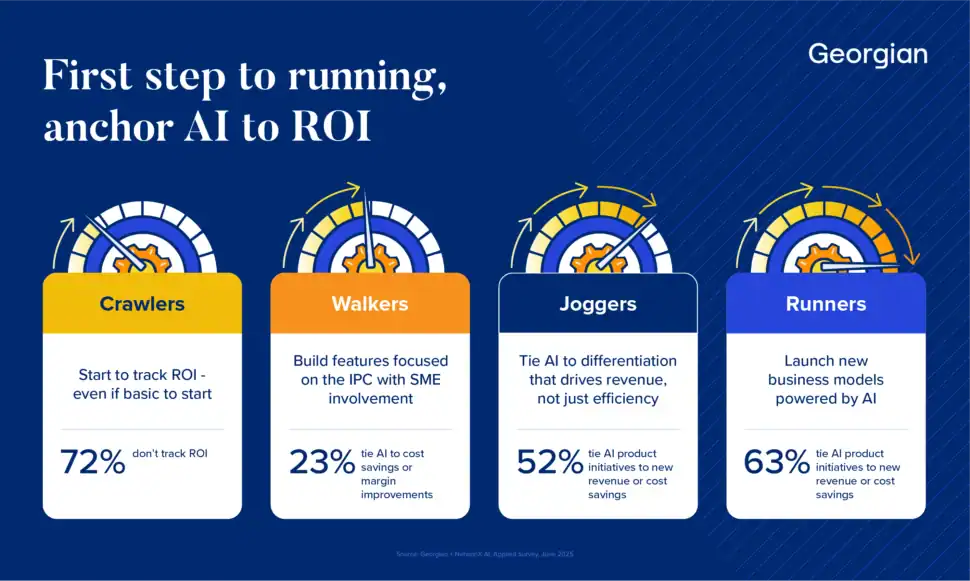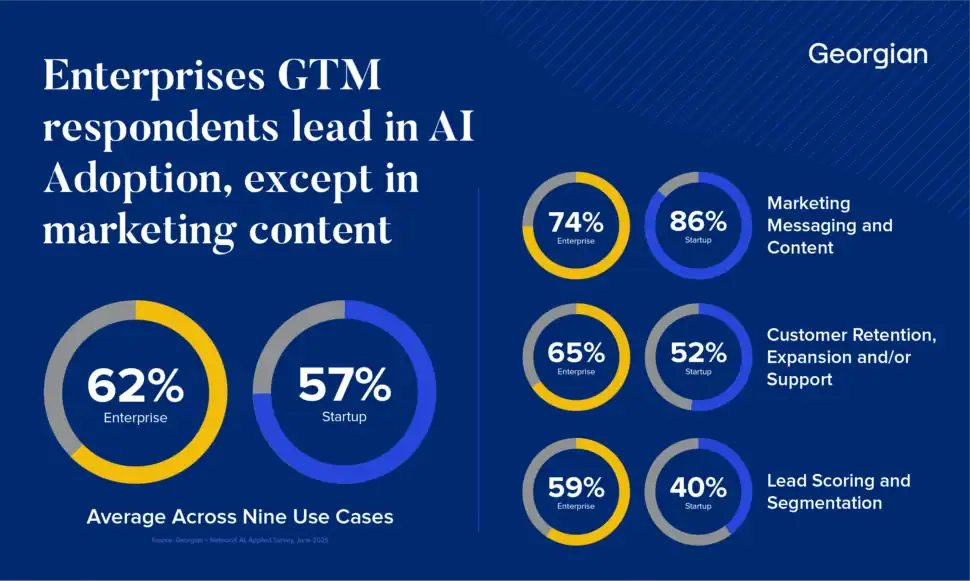
Enterprise vs Startup GTM AI Adoption: are startups really ahead?
Myth-Busting with David Berkowitz and AI Marketers Guild
First, let me answer the question posed in the title: No, startups aren’t ahead of enterprise in GTM AI adoption. This is surprising when compared to earlier technology waves where smaller start-up companies typically adopted new technologies faster than large enterprises. The tech integration speed of smaller startups has generally been attributed to the agility, lack of legacy systems, and acute need for rapid competitive differentiation found in small early-stage companies.
If you’re a start-up selling into these large enterprises, it’s helpful to understand why the pattern of earlier tech waves is not repeated in GTM AI adoption. After spending 25 years steering growth-stage companies in various GTM roles, I now have the privilege of working with over 50 Georgian portfolio CEOs and GTM teams in partnership with Georgian’s AI Lab. It’s exciting to see the AI evolution rapidly unfold across such a diverse set of companies. It’s also interesting to bear witness to some of the business myths being created in its wake.
Recently, I had the pleasure of joining my longtime friend David Berkowitz for an AI Marketers Guild webinar, where we dug into the real-world application of AI across enterprises and start-up B2B companies. We shared fresh data from Georgian and NewtonX’s Wave 2 AI, Applied Enterprise Benchmarks Report.
We did not rehearse. We did not discuss the data beforehand. Here are five takeaways from that discussion, with implications (from our view) for start-up companies looking to sell into these enterprises.
Takeaway 1: Enterprises Seem to Be Adopting AI Quickly—Often Outpacing Startup Teams
What We Observed
46% of enterprise execs surveyed say their companies are either jogging or running along the AI maturity curve. That’s ▲4 pts higher than start-up teams (42%)
The classic narrative is that startups, being nimble and in greater need for market advantage, tend to lead in adopting new tech while large enterprises lumber along. The data tells a different story. In the AI wave, enterprises may be moving just as fast—and sometimes faster—than start-up companies. Why? We believe it’s because the need for cross-functional, scalable AI solutions is more acute, and large organizations are more likely to have the mandate, resources, and technical foundations to make it happen quickly.


James’ Take
I’ve never seen enterprise adoption move this quickly for any technology. The old ocean liner (e.g. slow and bulky) vs. kayak (e.g. nimble and quick) metaphor doesn’t hold here—big companies are leveraging their infrastructure and talent to institutionalize AI. In many cases, large enterprises appear to be better positioned to scale and standardize AI than their smaller, resource-constrained counterparts.

David’s Take
I would echo this, and point out that many of the differences you would expect to see between enterprise and growth companies seem to have been minimized when we look at AI adoption—and in some cases the roles have been reversed. Enterprises, with their data, processes, and institutional strength, can drive AI further and faster than we give them credit for. Teams can rally on their own to run pilots, share best practices, or seek individual productivity. The barriers of past technology waves do not seem to be as present with AI.
Enterprise Sales Tips for Startup Teams
The “wow” factor of AI is behind us. It seems that everyone in the market can demo the magic of AI. And according to Georgian’s AI, Applied Benchmarks, over 90% of GTM professionals surveyed are using AI in their work in some capacity. We believe the real advantage for new AI-first companies or AI features added to legacy software lies in addressing many of the issues that enterprises have shared for decades: customer service, ease of integration, pricing, and security.
Takeaway 2: The Runners’ Mindset: Breadth of Use Cases, Depth of Integration, and Attributable ROI Define AI Runners
What We Observed
Throughout our AI, Applied Benchmarking, we segmented respondents as “crawlers, walkers, joggers, and runners” along the AI maturity curve. “Runners” tend to deploy AI across multiple functions quickly, scale pilots into production effectively, and tie their AI initiatives to concrete enterprise KPIs like cost savings or revenue impact.


David’s Take
I have to stress the importance of learning by doing and spreading AI know-how. At the current pace of change for AI, what was ineffective last month might be highly effective this month. Runners turn AI into an institutional learning requirement, not a hobby for enthusiasts. Joggers become runners through organizational learning (not just individual champions ). It’s also clear that this is not an easy task—only 16% of enterprises surveyed are running; only 13% of startups surveyed are running. We have a long way to go.

James’ Take
In Georgian’s view, three things define a runner: breadth (e.g. AI used in many functions), depth (e.g. scaling pilots), and a clear focus on ROI. A runner’s focus on ROI is important–having the discipline to tie AI efforts directly to cost savings or revenue has the highest correlation to AI maturity as a runner s. Executive mandates and clear KPIs will be key. Have your team measure ROI and report back, but do not be discouraged if ROI is not there on the first review. I agree with David – it’s the institutional mandate that will make the difference between runners and the rest.
Enterprise Sales Tips for Startup Teams
In our opinion, if you want to win in the enterprise, build businesses that connect directly to growth or savings, and aim to help your customers become AI runners. This may require robust AI features in your core product, and likely it also means making institutional learning easy, perhaps with emphasis on ease of integration, training, and differentiated customer service based on the stage of AI adoption you see with that particular customer.
Takeaway 3: AI’s Production Sweet Spot for Enterprise GTM Teams?: Customer Support (57%), Analytics (56%), and Personalization (29%)
What We Observed
Our research—supported as well by attendee anecdotes during the AI Marketers Guild webinar—show that enterprise respondents are putting AI to work in customer support (▲18 pts) (e.g. chatbots), data analytics (▲15 pts), and personalization (▲9 pts) at a faster clip than their start-up counterparts. Surveyed organizations that are running may be “talking to their data” via AI agents, even when it’s scattered and unstructured.

 James’ Take
James’ Take
The epiphany amongst enterprise respondents is the realization that AI agents are starting to enable conversations with their data, regardless of how fragmented it is. This could be a game-changer for organizations that have struggled with data silos and legacy systems. I believe we are heading to a place where companies just need clean, quality data in a secure location, and can leave the rest up to a good agent with a well-trained GTM prompt engineer to surface actionable insight.
 David’s Take
David’s Take
Enterprise growth requires more marketing data, more sales data and more customer interactions than is the case with start-up companies. More data likely equates to better returns from AI-powered support, analytics, and deep research insights. For growth companies, this means the scope for AI value is inherently narrower. The GTM data footprint is simply smaller; hence the more limited value of AI at that stage of growth for many companies.
Enterprise Sales Tips for Startup Teams
If you aim to sell into the enterprise: remember the amount of data and number of integration points enterprises have in their control. Creating AI features and enabling integrations that turn enterprise data into an advantage may be a differentiator. And as we’ve previously suggested, ease of integration, availability with hyperscalers like AWS, Azure, or GCP, or a strong customer support team will be important in the early stages of AI enterprise adoption and are more likely to lead to successful outcomes when selling into them.
Takeaway 4: Branding and Content Quality: AI Is Raising the Bar, Not Lowering It
What We Observed
Surveyed start-up GTM teams are reporting more positive ROI outcomes from their AI efforts (Marketing efficiency 84% ▲8 pts ; Sales efficiency 74% ▲6 pts ) than enterprises.
There’s been a lot of hand-wringing about AI-generated content diluting brand quality. But in practice, it would seem that enterprises are already using AI to enforce brand guidelines and consistency at scale. This is one area we believe where startups have the opportunity to quickly equal, or even gain advantage over, their enterprise counterparts. The brand advantage of Enterprises is potentially weaker in the era of AI as startups can sprint through branding and codify standards faster by using AI. Further, AI can then help uphold these standards more quickly and easily than in the past across every aspect of the business – product, marketing, sales, and customer success.

David’s Take
Anecdotally, I’ve heard some enterprises worry about over-reliance on AI. This may be the only reason the positive impact gap between enterprises and start-up teams is not wider. In my opinion, enterprises have all the advantages when it comes to AI’s power – more data, more proprietary content, more time in market, more resources – but there remains a hesitance to fully commit. Conversely, startups have nothing to lose and can absorb more risk given their disadvantages. This probably explains the results we see in the AI, Applied Benchmarks when it comes to the measurable value of AI.
James’ Take
I don’t buy the argument that AI will degrade content quality. In fact, many Georgian portfolio company CMOs have reported the opposite—suggesting that AI is an opportunity to codify, enforce, and scale brand guidelines and persona work better and faster than ever before. Startup companies that used to be “sloppy” or “loose” at branding can now level up in a matter of months by deploying agents with well-defined standards that easily enforce the consistency and quality that successful marketers desire. In this area of GTM, when it comes to AI, I believe the advantage goes to startups.
Enterprise Sales Tips for Startup Teams
Consider embracing AI as a brand enabler. Effective AI use can assist you in looking, sounding, and acting like a premium enterprise brand in your GTM work; use it to codify and enforce your messaging, and empower your team to move faster without sacrificing quality. For startups, a focused sprint on branding with AI may deliver results that previously took years, and it will help you “look their equal” when selling into the enterprise segment. That matters.
Takeaway 5: RevOps and Data – The Next Frontier for GTM AI Transformation
What We Observed
For enterprise respondents, AI is beginning to revolutionize Revenue Operations (RevOps) at a faster clip than startups (67% ▲2 pts) particularly in areas like lead scoring and segmentation (59% ▲8 pts) and customer support and expansion (65% ▲13 pts).
The challenge may not be collecting data anymore, but rather organizing, governing, and making it actionable across teams. The real value of AI is potentially unlocked when data is clean, accessible, and integrated with a conversational AI agent on top. RevOps leaders should take note and consider the opportunity to upskill with AI, potentially securing for themselves a promising future in the AI evolution.

James’ Take
I believe RevOps is about to be dramatically impacted. We’ve seen in the AI, Applied Benchmarks that organizations are slowing down or outright moving away from bloated martech stacks toward a leaner, higher-quality data and automation layer. AI can become the connective tissue that integrates disparate sources and brings actionable insights to the surface. It’s the actionability factor that is often a struggle for RevOps teams that find themselves battling an internal operation as opposed to driving the business.
David’s Take
I see a future where RevOps is powered by AI that unifies data, automates content creation, and streamlines collaboration—freeing teams from endless one-off requests and letting them focus on strategy. AI may not only help teams “talk to their data” and break down silos, but it can continue downstream turning those data conversations into content, objection handling, account-based insights, the list goes on…
Enterprise Sales Tips for Startup Teams
Consider prioritizing private and public data integrations for your AI product features. Make it simple, and privacy compliant, for the enterprise buyer to harness their private data endpoints regardless of data structure and perceived quality. The Revops function will potentially hold more sway than ever in the enterprise, especially for those enterprise teams that upskill this function as they recognize the opportunity presented by AI. Startups should consider addressing this persona in the sales process as a major influencer, a champion, or perhaps even the buyer.
Final Thoughts
We believe that the pace of AI adoption from crawler to runner will only accelerate in the coming months. We believe the winners are likely to be those who take a “runner” mindset now: integrating AI across functions, tying it to real business outcomes, and using it to raise the bar of efficiency and revenue in measurable ways.
Want more? Download all the benchmark reports and join us for a future session with GTM partners — where we’ll look ahead to the GTM team of 2027 in the age of AI.
Read more like this
KumoVC: Turning Venture Data into Instant Predictions with KumoRFM
Originally published on Kumo.ai’s blog. In this technical blog post, Azin and…
Verticalized Voice AI – The Next Application Layer Shift
Every decade or so, a new interface reshapes not just how people…
Agentic AI and the Rumors of SaaS’s Demise
Introduction: A Conversation About Big Shifts When I joined Tobias Macey on…